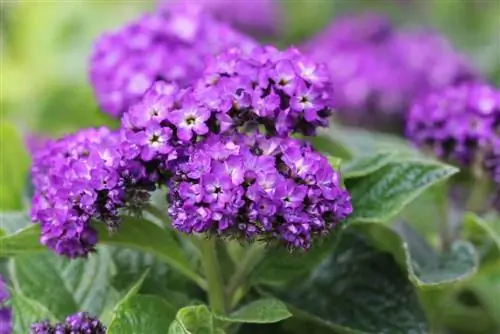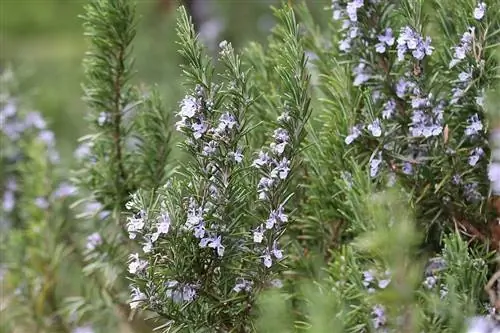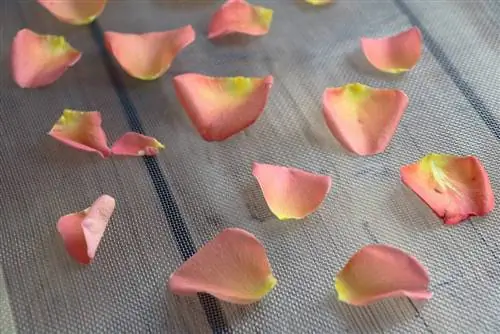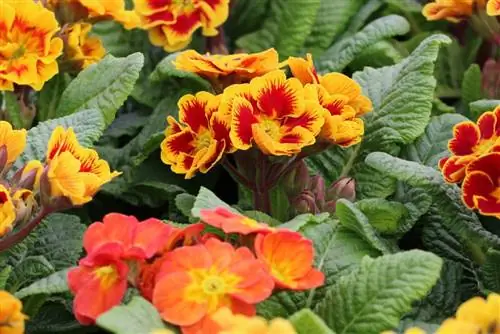- Author admin [email protected].
- Public 2023-12-17 03:39.
- Last modified 2025-01-24 12:45.
The vanilla flower, also known by its Latin name heliotrope, is usually cultivated in this country as an annual pot or hanging plant. It is a sun-hungry flowering plant that prefers a location in full sun and at most partially shaded. Unfortunately, the heat-loving plant is not winter hardy, but can easily be overwintered in a suitable, frost-free and bright room. In winter quarters it requires little care.
Vanilla flower is not hardy
The lavender-blue or white-flowering, sweet vanilla-scented heliotrope comes in its original form from the Peruvian Andes. However, anyone who sees snow-covered mountain peaks in front of their eyes and is hoping for a robust, frost-hardy balcony flower will now be disappointed. Heliotropium arborescens does not grow in a harsh mountain environment, but at altitudes of only up to 500 meters. A mild rainforest climate prevails here all year round, which is why the vanilla flower is of course not used to frost and is therefore not hardy.
Why overwintering is worth it
When caring for plants that are not hardy, you have two options: Either you enjoy the wonderful flowers between May and October and then throw the dead plant away, or you overwinter them according to their special needs. This sometimes takes a bit of effort, but can be worth it. Heliotrope, for example, develops with age into a tree-like plant up to one meter high with an often spherical crown. The stately tree produces many leaves and flowers and is an ornament for balconies and terraces. However, if the flower is only kept as an annual, it remains as small as a bush and does not become woody. For lovers of something special, wintering is worthwhile because a small vanilla flower tree is a rarity.
Tip:
Anyone who has children or pets should be careful when cultivating Heliotropium arborescens. All parts of the plant are highly poisonous! This is especially true for wintering indoors, when access is easier and the child can secretly taste the seductively scented plant.
Which varieties survive the winter best?

There are now a whole range of different varieties of vanilla flowers that have been bred from the original natural form. Experience has shown that the original form is easiest to get through the winter, the cultivated forms - they are often hybrids, i.e. H. around crossings - are usually more sensitive and will take offense to care mistakes more quickly in winter. Ultimately, however, the specific variety is irrelevant: choose plants that are as strong, he althy and grown in Central Europe as possible. These have a higher chance of surviving the cold season - in contrast to cheaply produced and well-traveled specimens. When they are purchased, these often suffer from the stress of having to be raised quickly and travel long distances, so that they are not able to cope with the rigors of overwintering.
Proper care of the vanilla flower in winter
During the summer months you should treat the plant carefully and according to its needs. This way she stays he althy and recharges her batteries for the coming winter months. Make sure Heliotrope
- get as much sun as possible
- a location in full sun is mandatory
- warm and protected
- no drafts
- the root ball is always sufficiently moist
- but not too wet
- and there is sufficient fertilization
It is a heavy feeder that needs both plenty of water and lots of nutrients. Water regularly throughout the growing season, but gradually reduce waterings beginning in early September. You should also stop fertilizing from the end of August / beginning of September at the latest. In winter, water is used sparingly so that the rhizome does not dry out.
The right time to put away your winter quarters
Heliotrope does not tolerate temperatures that fall below five degrees Celsius. Therefore, you should move the plant to its winter quarters at the beginning of October, before it gets really uncomfortable in autumn. In addition to cool temperatures, cold, constant rain and wind can also damage the plant. Keep a close eye on the weather: instead of bringing the vanilla flower inside straight away, it should stay outside as long as possible. If October is golden, sunny and warm, leave them on the balcony and, if necessary, only bring them in overnight. The longer the plant gets light and air, the he althier it remains - and the better it survives the winter quarters.
Pruning before overwintering
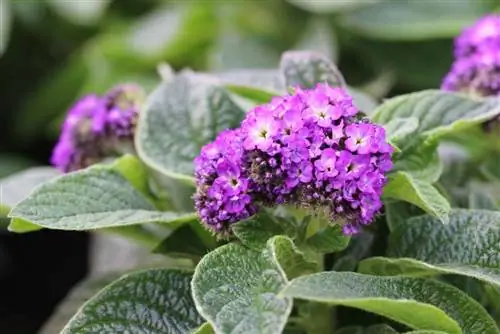
Don't put the plant in a cool room straight away, but give it a short period of transition. This way she can get used to the new conditions better and the shock of rearranging is less severe. Light pruning is possible, although you should not cut back the entire plant by more than a third. The roots must not be cut as heliotrope is very sensitive here. As a result, severe pruning does not make sense; after all, the balance between root mass and above-ground leaf mass must be maintained.
Optimal care in winter
Put away in its winter quarters, the vanilla flower now only needs a little care. Other than watering every few weeks, you don't need to care for the plant. The optimal location is more important anyway: Since it is an evergreen plant, it needs as much natural light as possible, even if it is kept cool over the winter. The rule of thumb is that the warmer the flower is, the brighter the winter location must be. Temperatures between at least five and a maximum of ten degrees Celsius are optimal. So place Heliotrope in a window seat (ideally a south-facing window!) in an unheated room, such as a winter garden, a garden shed or a stairwell.
What to do if the vanilla flower loses leaves?
Over the winter months, some of the edges of the leaves turn slightly brown, and individual leaves may also dry out and fall off. This behavior is completely normal, especially since the plant will sprout again next spring. However, if the leaf fall increases and more green or yellow leaves are shed, the flower is probably too dark. A brighter location or the additional installation of a plant lamp helps here. However, the increased leaf death can also be due to too frequent watering: Therefore, carefully check the moisture of the substrate with your finger before each watering. This should not dry out completely, but should no longer be moist either. Waterlogging causes root rot and is therefore definitely fatal.
Preparing for clearing out in spring
From around March, gradually warm up Heliotrop and increase the watering intervals to the same extent. However, keep in mind that the warmer it is, the brighter the flower needs to be. If necessary, repot them in fresh substrate and possibly in a larger pot, taking care not to damage the roots. Then clean out the plant and remove shoots that have died over the winter, as well as those that are sick and weak. If the vanilla flower is not planted in fresh, pre-fertilized substrate, provide it with a liquid long-term fertilizer for flowering plants. However, the flower is only allowed outside when there is no longer any danger from night frosts. This is usually the case from mid to late May.
Tip:
Don't suddenly move the plant into the blazing sun, but rather get it used to it slowly: This is done by first placing it in the partial shade for a few hours and then making it a little brighter from day to day and leaving it outside for longer. Otherwise there is a risk of sunburn on the leaves.
Does planting in the garden make sense?
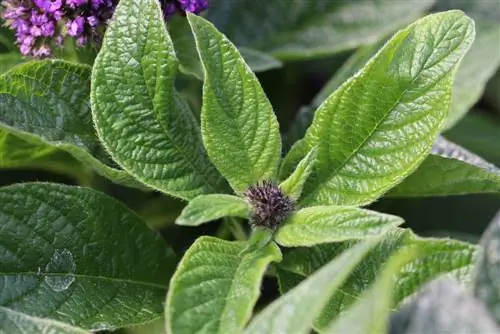
While heliotrope only grows to a height of up to 50 centimeters in a pot as an annual, when planted out in a bed it reaches a height of up to 80 centimeters and becomes very bushy. Some gardeners leave the flower in the flowerbed over the summer (for example, buried in a pot) and then dig it up again in the fall. In principle, this procedure is possible, but carries the risk of root damage - to which Heliotropium arborescens is very sensitive. Overwintering outdoors is only conceivable in correspondingly mild regions - for example on the Mediterranean or in some wine-growing areas such as the Moselle region - and with appropriate protection.

